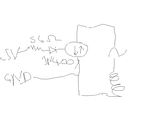boylesg
Advanced Member level 4
- Joined
- Jul 15, 2012
- Messages
- 1,023
- Helped
- 5
- Reputation
- 10
- Reaction score
- 6
- Trophy points
- 1,318
- Location
- Epping, Victoria, Australia
- Activity points
- 11,697
I have just played around with a MAC97A, just with 24VAC and a solenoid plus a 5VDC plug pack.
I triggered the gate through a 1N4007 and 56R resistor.
Eventually figured out that you need to connect DC GND to one of the triac terminals for it to trigger.
Is there any better way of protecting the DC circuit from the AC current than what I have done with the 1N4007?
I triggered the gate through a 1N4007 and 56R resistor.
Eventually figured out that you need to connect DC GND to one of the triac terminals for it to trigger.
Is there any better way of protecting the DC circuit from the AC current than what I have done with the 1N4007?
